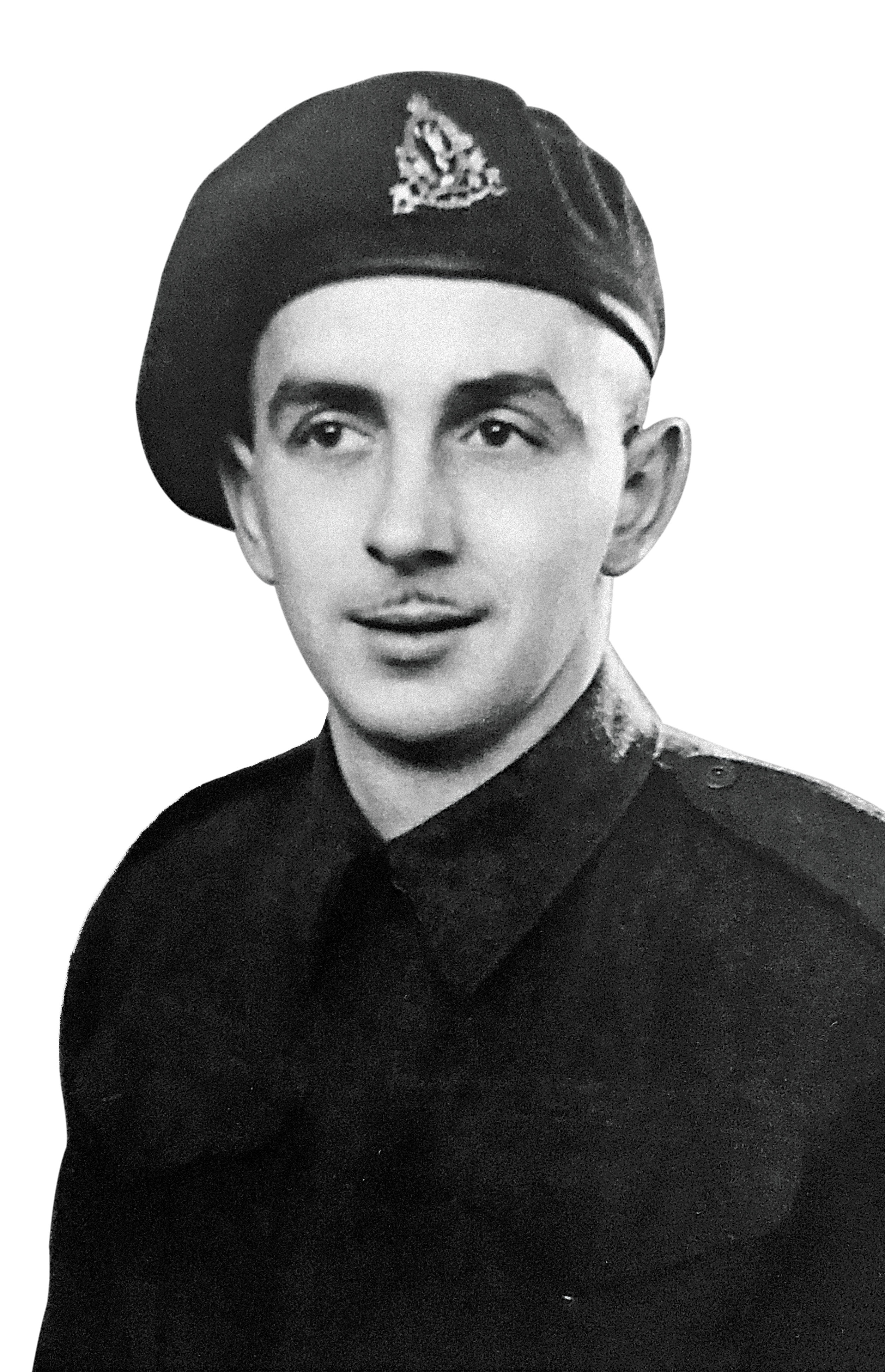
Wearing the cap badge of the Royal Canadian Corps of Signals, Allan Wallace Coburn posed for a studio portrait in 1945. [Courtesy of Douglas Allan Coburn]
During the Second World War, 21-year-old Allan Coburn was one of a million young men and women whose sense of duty and hankering for adventure drew them to serve in the Canadian Army.
He was “the second son of a farmer, with no passion for farming,” said his son Douglas Coburn of Winnipeg. “So, what to do?”
Join the Royal Canadian Corps of Signals.
Allan Coburn enlisted on Jan. 9, 1942, leaving his parents Dwight and Isabel, older brother Ted, younger brother Glen and little sister Kitty on the family farm near Carman, Man. After basic training, he joined the tank brigade signals, which was reorganized into the 2nd Canadian Armoured Brigade Signals on July 26, 1943, after he got to England.
He served just shy of four years in England, France, Belgium, Holland and Germany. His mother Isabel wrote to him every Sunday and he wrote back, though not always weekly. His mother saved 89 letters, more than 100 postcards and 125 pictures. These mementoes offer a glimpse into the experiences of a typical soldier and his duties as a wireless operator.

Allan Wallace Cobur with buddies identified only as Coleman and Cooke in Surrey during the summer of 1943. [Courtesy of Douglas Allan Coburn]
Coburn faced a big obstacle in writing his letters home: he could not tell his mother where he was or what his unit was doing. Letters were censored and parcels home were searched.
“Our first security problem,” reads the unit’s history booklet, RCCS: Second Canadian Armoured Brigade Signals, “was when some of our members were discussing our trip over. Needless to say, we were all soon put on the right road about what not to say.”
“Really Mom,” Coburn wrote on May 28, 1944, “writing letters is the worst job I have to do. You have no idea what it is like when you have to be so hush-hush about everything…. I’m going to narrow my correspondence down to as few as possible. I’m well, so don’t worry, I may not write again for a while.”
Two weeks later, shortly after D-Day, Coburn went over to France, a newly minted lance-corporal.
The headlines on the front page of the Winnipeg Free Press on June 7, 1944, were all war-related: germans cleared from beachheads; allied troops fighting inland; fierce resistance met. Coburn’s parents could hardly have escaped news of the invasion.
“I’m in France with the boys,” said Coburn’s letter of June 23, 1944. “We had an uneventful crossing…. Jerry [the Germans] didn’t know we were there…. Don’t worry about me. I’m safe and am enjoying the ‘parlez-vous.’”
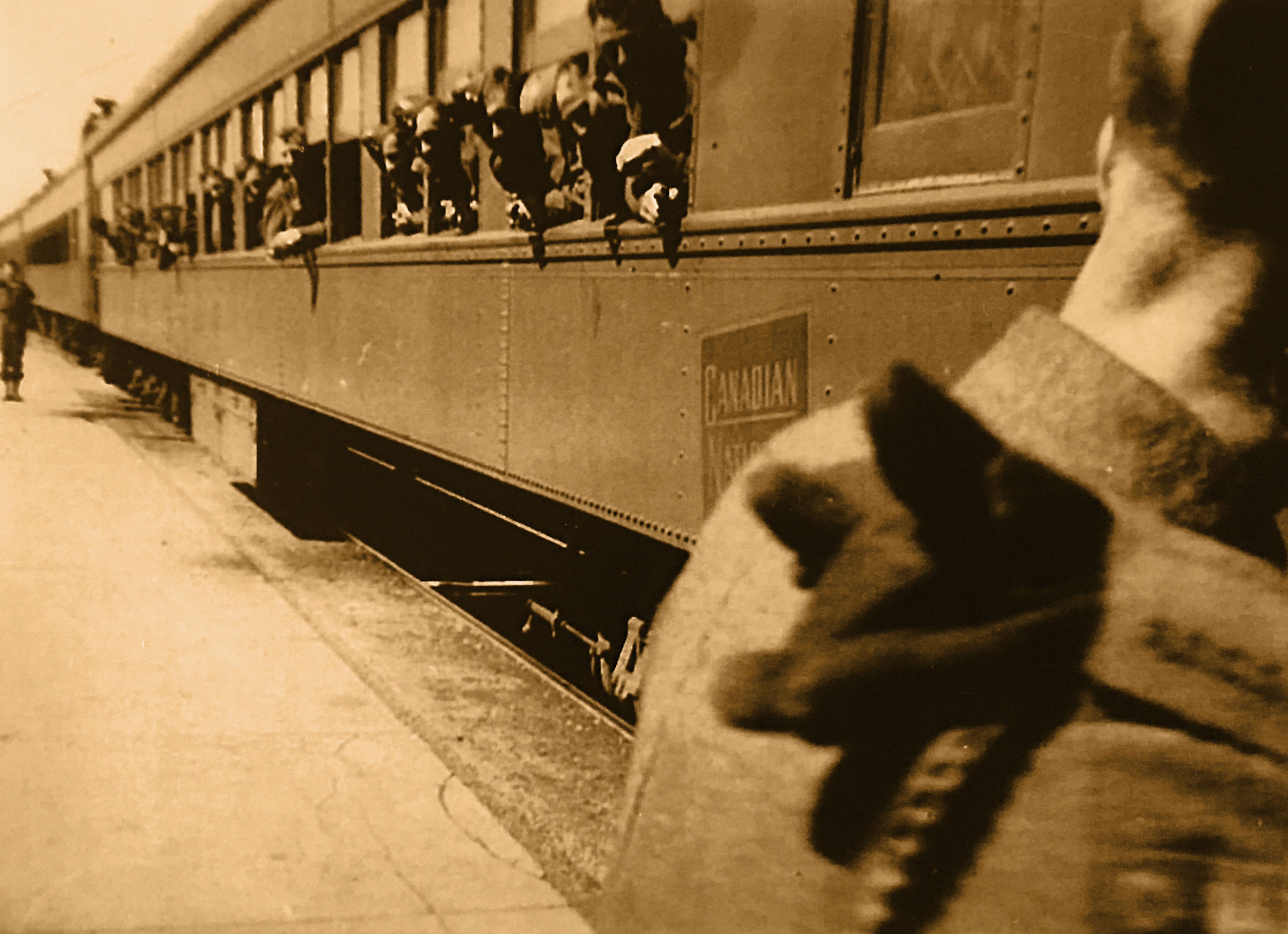
Coburn carried a camera through the war, photographing his troop train leaving for Kingston, Ont., in 1942. [Courtesy of Douglas Allan Coburn]
Over and over again, he reassured his family that he was safe and in no danger. That was hardly the truth. The signals brigade moved with the armoured brigade, which provided tanks and other equipment to support various infantry units as they fought through northwestern France, Belgium and the Netherlands to Germany.
“As soon as a foothold [is] secured, telephone lines [are] laid and dispatch riders [start] regular runs,” wrote Colonel C.P. Stacey in The Victory Campaign, the final volume of the Canadian Army’s official Second World War history. “The intricate network of rapid communications would be the basis of effective command in battle.”
Signallers set up and maintained communications between command and all units in the field. They laid wire and operated radios, telegraph and teletype machines in headquarters and from mobile units in trucks. Pay was $1.50 a day for signalmen, $2.65 for sergeants.
Coburn admitted several times to accompanying dispatch riders to the front “just for something to do when I’m off duty,” keeping to himself the dangers signallers routinely faced: shellfire, strafing, snipers and V-1 flying bombs.
If communications broke down, signallers had to find out why and restore service. If a radio unit went out in a tank, a signaller was sent to repair or replace it. They often travelled by truck through countryside not yet cleared of enemy soldiers. They travelled as surreptitiously as possible, frequently by night. With no road signs and a ban on headlights, they often got lost.
“Life here is quite uneventful, although we have some excitement at times,” he wrote on July 9, 1944. An understatement indeed. The Canadians had just emerged from the battle for Carpiquet airport, defended by machine guns, mortars, anti-tank traps, anti-tank guns and anti-aircraft guns. Canadian tanks were fitted with flails to set off mines before they drove over them.
“The hardest part of all is to hear of fellows you know being killed, but we have to get used to that. All my close chums are OK so far and I haven’t had any occasion myself to even be scared.”
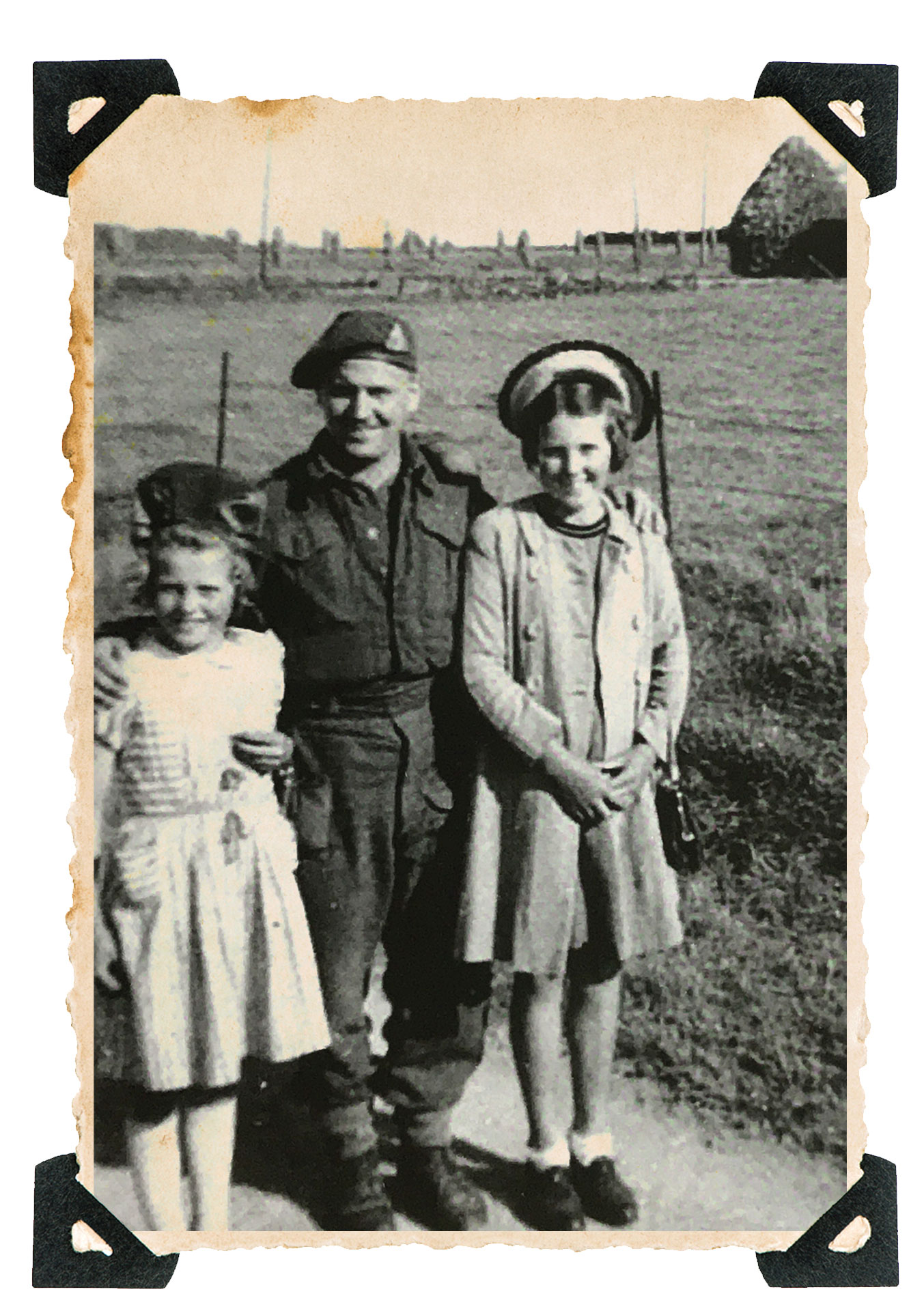
Joe Primeau with two French girls. [Courtesy of Douglas Allan Coburn]
In many letters, Coburn thanked people back home for parcels containing handkerchiefs, gloves, a comb, socks and soap. He shared jam, honey and cakes with comrades; traded cigarettes and sardines with locals for fresh eggs; and gave candy and chewing gum to children.
He described where he was housed: billets in people’s homes, barracks, schoolhouses, churches and tents. In a “new camp, I immediately look for some straw. I put it on the ground under a big tree if one is handy and put my tent over the whole thing. It’s quite snug and with my straw ‘mattress’ I’m quite comfortable.”
A mobile bath unit came once a week and the troops were issued clean clothes and given time to do their laundry.
“My weekly wash consists of a shirt, summer drawers, and a couple of pairs of socks. We have a square tin can with some holes punched in the side [for draft], and fill it half full of earth. Then we pour some gasoline into it till the earth is soaked and set a match to it. A four-gallon petrol tin is placed on top of this with water in it. It doesn’t take long to boil, either.”
The war continued in the background. Leading up to Operation Exercise, the Allied assault on Verrières Ridge, on July 25, 1944, “we were under heavy air attacks with bombs dropping all around the area,” reads the unit history. “This day was very noisy…hard fighting on the entire Corps front.”
Two days later, “German bombers made life in the area of main HQ very uncomfortable by dropping anti-personnel bombs in our vicinity.” Several signallers were wounded, but Coburn was not among them. On Aug. 8, the first day of Operation Totalize, the attack to cut off the German retreat through the Falaise Pocket, two signallers were killed, eight wounded and many vehicles damaged.
“Members of the unit carried out a minesweeping detail…and approximately 120 mines were found,” says the unit history. “With the enemy on the run, September moves took place rapidly,” with rear and main headquarters each moving five times. Communication with tank corps was difficult, and the weather was wet and cold. “Branches were used to make a roadway…and tanks were often required to tow the wheeled vehicles out of the mud.”
“I am seeing quite a lot of France,” Coburn wrote on Sept. 6. While most of his wireless work was conducted back from the front line, he did witness the war at close quarters: “I went…visiting the forward area and saw quite a bit of the scrapping that’s going on,” he wrote on Oct. 10. “Lots of gun flashes and shells landing. We passed lots of Jerry prisoners being marched down the road.” As they passed, French civilians hurled abuse.
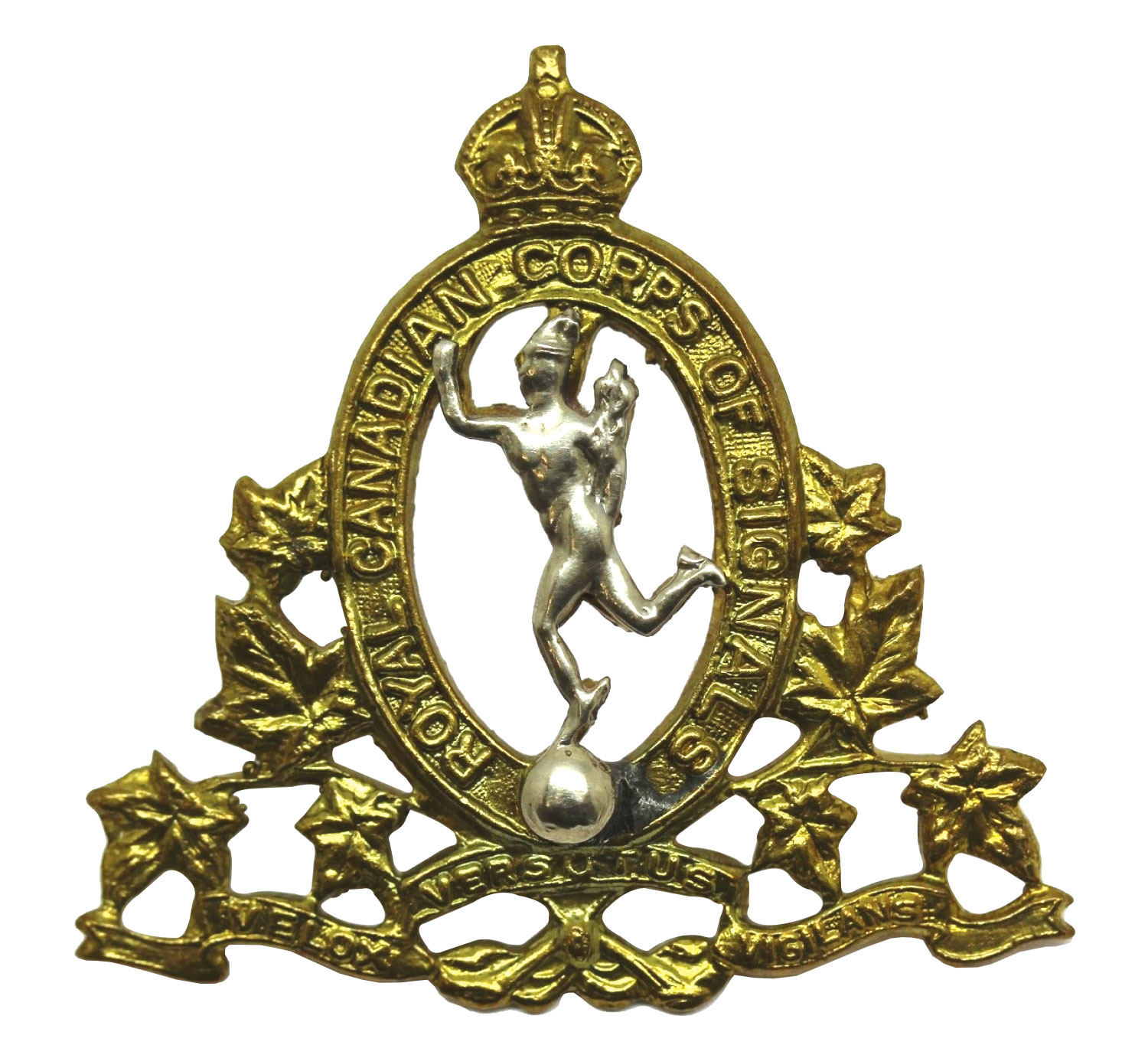
The badge of the Royal Canadian Corps of Signals carries the motto Velox, Versutus, Vigilans (Swift, Skilled, Alert). [Courtesy of Douglas Allan Coburn]
Coburn’s letters are sprinkled with observations about local people and customs. He described French farming and Belgian baking: “They don’t use much binder twine here [during threshing]. Mostly the sheaves are tied with a long braid of straw. You should see the size of the stooks [sheaves stood on end to keep the heads drier].” “I spent an afternoon in Antwerp. Bread costs so much and is so scarce that they make their own flour,” crushing grain in a hand mill then sifting it.
On Oct. 22, Coburn answers some questions from his mother. “Yes, we see the same stars here as you do and I often look up at the Big Dipper and wish I was standing in our backyard watching it.
“Our food isn’t bad but not much variety. Mostly canned stew and beans, but we get fresh white bread most of the time. If supplies don’t reach us in time, the cook opens a big can of hardtack instead. I’ve long since lost all enjoyment in eating.
“We have lots of radios…. We get all the latest songs and news.
“I finally got a Jerry pistol. It’s known as a P-37 and is a real weapon. I tried it out today. Glen will be quite interested when I bring it home.”
“Don’t worry about me getting shot. If that was going to happen, it would have happened a long time ago.”

Coburn’s friend Welsh washes socks in a basin attached to the side of the truck. [Courtesy of Douglas Allan Coburn]
In November 1944, the Battle of the Scheldt drew to an end, opening Antwerp to Allied shipping. The front moved quickly, and main and rear signals headquarters were constantly relocated, once with such little notice that men given a pass to go to town returned to find their unit had relocated, and themselves in a game of hide and seek.
Coburn wrote home from Holland on Nov. 1. “They sure welcomed us here and almost everybody has a home to visit in the evenings. They have been existing on the barest of food and clothes. We saw a man digging a hole…and bringing out suitcases of clothes. Everyone hid their bicycles as the Germans took them too…. [Most people understand] English and don’t feel backward about talking to us. They are full of questions about Canada. They all want to know how the war is going, as few have radios because the Germans collected them all.”
He again reassures his worried mother: “About the only time I have a chance to visit the front lines is when I go up with one of our dispatch riders in his scout car. I hope the censor doesn’t think this information has any military value.”
And on Nov. 6: “I met a real nice Dutch family [and visit most evenings]. The daughter has a girlfriend from Rotterdam living with her so you can see what the attraction is. They treat us just like one of the family. It makes you feel more like a human being when you have a ‘home’ to go to, instead of hanging around the barracks.
“There isn’t much doing and we are having a rest. Tomorrow night the Signals…are having a dance downtown. It promises to be a lively affair, but we are not having any strong drinks so it won’t be rowdy. We mustn’t leave a bad impression.”
The unit history on Nov. 7 reports that “HQ moved to Breda. That night a most successful unit dance was held. Over 100 turned out for the dance and some 70 girls from homes in the Breda area kept them occupied.”
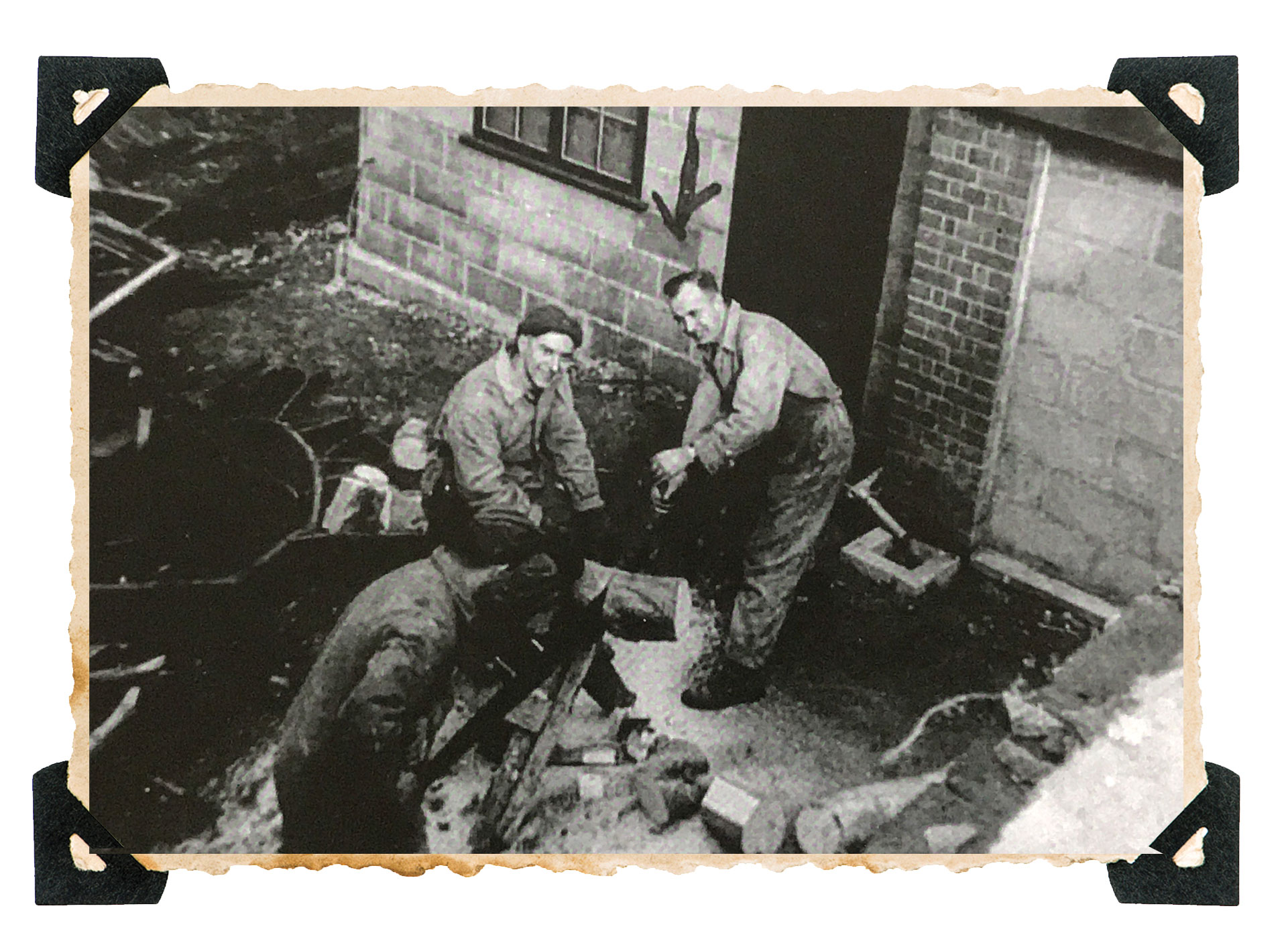
Coburn and comrades team up to cut firewood in 1943. [Courtesy of Douglas Allan Coburn]
On Nov. 25, the brigade headquarters settled in Niftrik, near Nijmegen, for nearly three months, using this downtime to get equipment ready for action in the spring.
Facing his third Christmas away from home, Coburn wrote on Dec. 7: “We went to a large town near here to see a show…. Why can’t they give us other pictures besides films about war? It’s hard enough to see it every day without going to a theatre and seeing it too. Most of us have had our fill of this sort of thing and would appreciate a film of life in Canada or America or any picture at all as long as it didn’t have anything about war in it. Most of us come out of the theatre feeling worse than when we went in [having to live] through the hell of it again.”
The unit’s war heated up in mid-December, says its history. “V-1s—19 were counted in a 12-hour period, some exploding nearby.” By Dec. 18, one was falling every hour. “Our air action was noted most days. Dec. 22, we were alerted to enemy airborne landings and were turned out to patrol the area.”
Homesickness is a theme in Coburn’s December letters. On Dec. 11: “I’ve got good news. Every man…is to get seven days leave in England. I expect to be going on leave sometime in February. Of course, I wouldn’t mind if the war was over and I can go all the way home instead.”
Dec. 17: “This will be my third Christmas away from home, and Jan. 8 will end my third year in the army. I often wonder how much longer it will be till I can come home for good. Even if the war ends now, how long will it be till conditions in Europe are stable enough for us to leave? I can’t grumble. I’ve had a good job over here and not much danger attached to it. All in all, I’ve had a peach of a time compared to some of the boys. [But] I’d give $100 for a soft bed and a comfortable night’s sleep.”
“New Year’s Day 1945 came in with a bang,” reads the unit history. “There was great enemy activity. Six FW190s flew around the general area, strafing roads and buildings.”
“I saw one of our planes shoot down two of them,” Coburn wrote. “It’s the most thrilling thing to see the way our boys handle their planes. The Jerries haven’t a chance from the start. They never attempt to put up a good fight. They just try to run away and that’s the end of them.
“Glen will soon be 17, won’t he? Tell him not to think of joining up. It’s a hard and lonely life for one, and has no good points to counteract its many bad qualities. I hope the censor doesn’t mind my opinion. It might ruin recruiting if it became public.”
“With the arrival of February,” reads the unit history, “enemy buzzbombs increased, road traffic became heavier and restricted, leaves were ceased, Allied air traffic noticeably increased, all of which indicated that action was being speeded up.
On Feb. 19, 1945, main signals headquarters moved into the Reichwald Forest near Cleve, Germany. “With the return to action in March, moves were to come suddenly once more. Enemy aircraft strafed our area on 1 March…much enemy shelling and mortaring.”
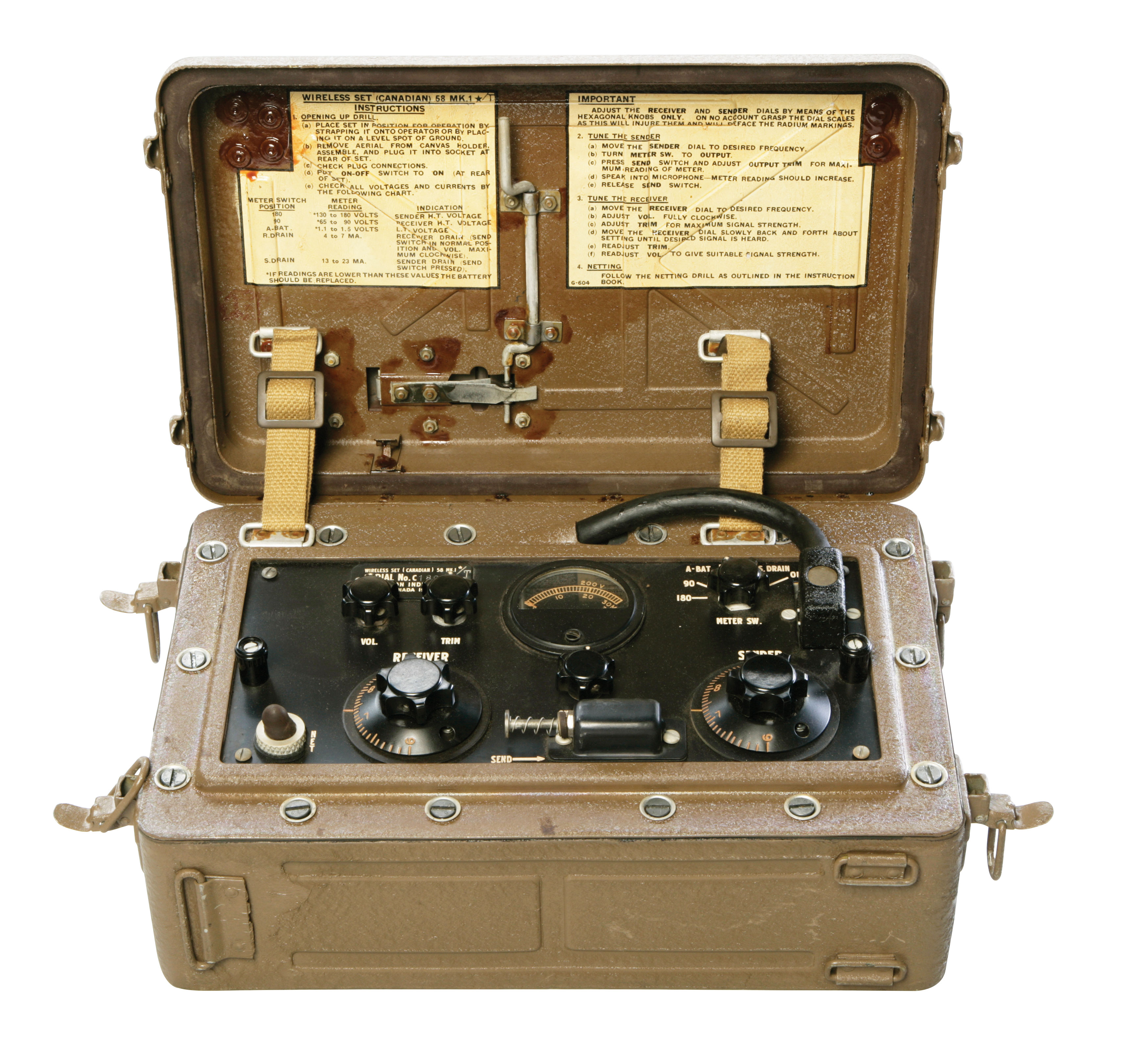
Wireless Set No. 58, built by Addison Industries of Toronto, was used by the Canadian Army for short-range communications. [CWM/20020045-037]
“Greetings from Germany,” Coburn wrote on March 8, 1945. “We haven’t linked up with the Russians yet, but watch your paper for future developments.
“My gang and I are out on relay work again. We have to keep in touch with our HQ and subunits by wireless and help them out when communication gets difficult. We like the job quite well as we are our own bosses and nobody bothers us.
“Mom, I don’t want you to think I’ve forgotten religion and prayer because I haven’t. There have been occasions where I’ve prayed very fervently, mostly because of fright, I’ll admit.”
And on March 19: “The past month has been very fast and eventful for me and I saw quite a bit of Germany. [Several cities he visited] are just heaps of rubble. I got lost in Uedem one night with the truck…. It’s very difficult to read a map through town as all the buildings are flat and the road is just a trail dug through the debris with bulldozers and steam shovels.
“I wish I could trade in my wireless sets and truck and go home. But I will have to wait a little longer. I think the next push will be the last, but it will no doubt be the most ferocious fight of the lot.”
On March 31, signals headquarters moved over the Rhine River in Germany, reporting that “shelling occurred daily in this area.”
“My gang and I are away…on our old job of relay wireless station,” Coburn wrote on April 1, 1945. “We are in an orchard…but there is no sign of the farmer. He and all the people around have moved deeper into Germany trying to escape us. There is plenty of loose livestock. One cow comes to our truck every day to be milked. So, we have all kinds of milk to drink and Bossie is very grateful.
The ferocious fighting continued. “It was very noisy the first few days we were here as there was a battery of guns just behind us and they kept pounding away night and day. About 20 of them, one right after the other and the noise was deafening, but we slept OK in spite of the noise.” On April 8, he wrote: “Right near camp is a launching site for V-1 flying bombs…aimed at Antwerp or England.” But now silenced forever.
And finally, “Tonight at one minute past midnight, the war is officially over. I feel rather like a boxer who has taken a bad beating.” The countryside is in turmoil “with Germans wandering down every road looking for somebody to surrender to, with dazed looks on their faces…no comparison to the ‘unconquerable’ Wehrmacht of five years ago.”
Lubrication is found for a celebration: “Thirty five-gallon kegs of cherry brandy were obtained from a distillery at Bremen, where in the basement due to some damaged vats, parts of the floor were under six inches of brandy,” says the unit history.
More than a million Germans had surrendered. “So ends the fighting.” The men “crowded around available radios to hear Prime Minister Churchill and His Majesty the King speak on 8 May…. May 10 brought 30,000 PoWs into our area to be guarded by our brigade.” And so started the chores of occupation and demobilization.
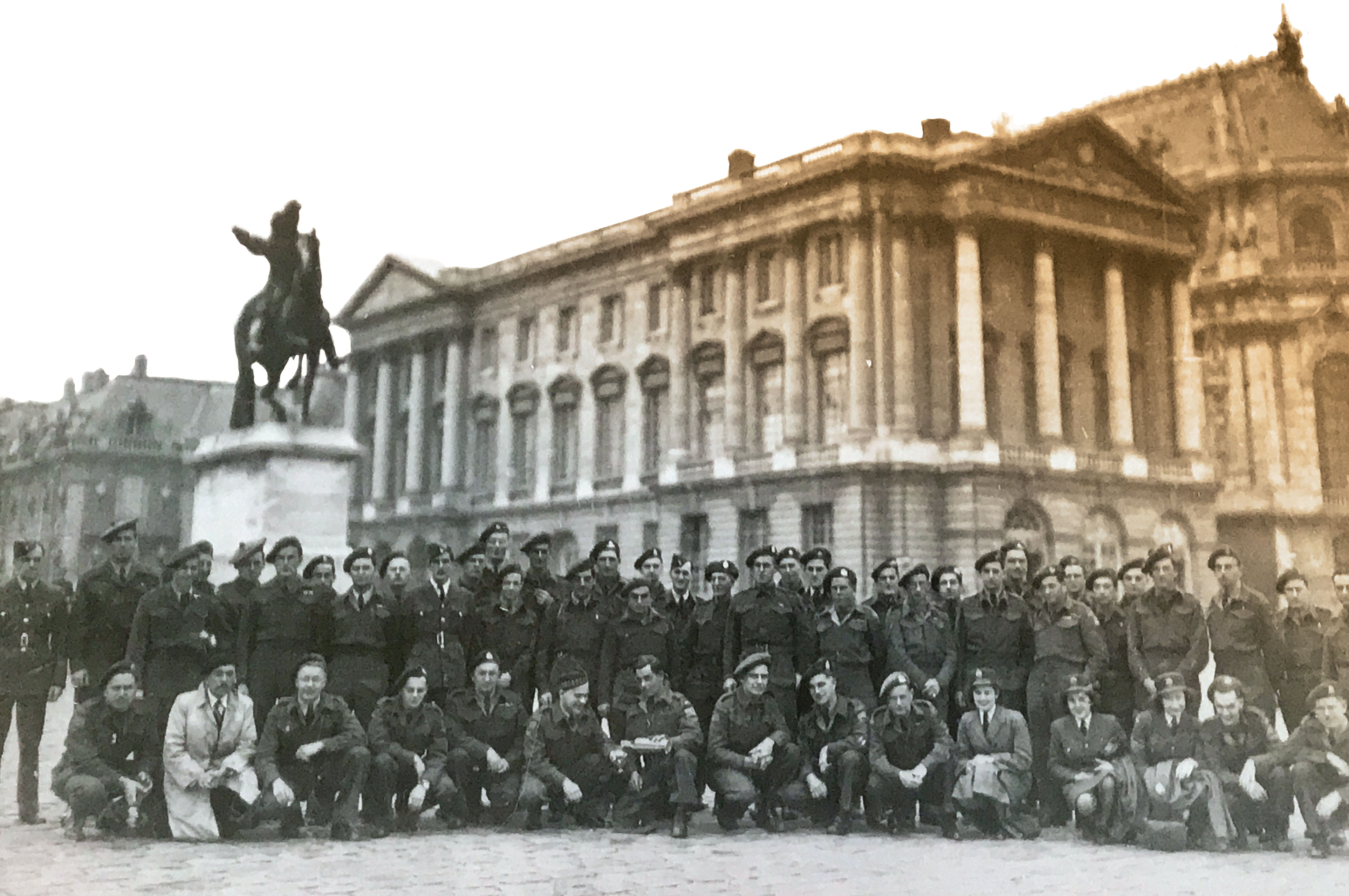
Coburn (standing, third from right) joined a group touring occupied Germany in 1945. “There is hardly a wall left standing,” he wrote to his mother. “Just heaps of broken bricks.” [Courtesy of Douglas Allan Coburn]
In the weeks it took for his unit to be demobilized, Coburn toured Germany.
“If you can visualize miles upon miles of wrecked buildings, heaps of brick rubble, dust and dirt and the smell of decay, then you might understand. I thought [French] cities were bad, but they were not nearly the size of Cologne.” Duren and Aachen were the same, he wrote. “There is hardly a wall left standing, just heaps of broken bricks. People had put pots of flowers and wooden crosses on some of the rubble piles…for people buried under the brick.
“Men are at a minimum in Germany. We saw about 15 women to each man. All the men we did see wore parts of their uniform…many were without an arm or a leg or walked with a limp.
“Most of the people sleep in the air-raid shelters and come out during the day to work cleaning away rubble. Others make enough to live on off the black market.”
The brigade was disbanded on June 25, 1945, its members “dispersed in many directions, leave, occupation forces, to other units and to return to Canada in preparation for more action in the Far East. So went many good men.”
Corporal Coburn headed home, a changed man.
“You know how discontented I was about the farm,” he had written earlier to his mother. “I had no interest in it and no responsibility. I’ve changed a lot, Mom. At least I know what responsibility is. You learn fast when you are entrusted with other fellows’ lives and expensive equipment. I’ve seen enough of the world and how other people live to be quite satisfied to return to Canada and be quite satisfied with all its faults.”
He returned to farming near Carman.
Advertisement





















